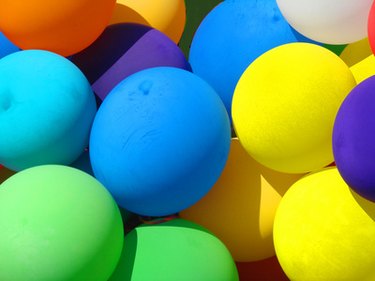
You huffed and puffed to blow them up yourself, or you paid good money for inflated balloons – and just a few hours later, your brightly-colored decorations are already starting to look cloudy. A process called oxidation is to blame when shiny balloons develop a chalky appearance. You can't stop oxidation from happening altogether, but a few simple steps can slow it down so balloons stay shiny and bright for as long as possible.
Why Oxidation Happens to Balloons
Video of the Day
Not all balloons experience oxidation. Foil balloons and vinyl balloons aren't susceptible to this process. It's only a problem with balloons made of latex. Most of the balloons that you can buy and blow up yourself at home, and many of the inflated balloons sold by retailers, are made of latex, a substance derived from rubber trees.
Video of the Day
As an organic material, latex degrades much more quickly than foil or vinyl does. Latex balloons are even sometimes marketed as being biodegradable, though it can take months or even years for them to fully break down. (This is why releasing balloons into the air poses a threat to wildlife and the environment. Fish and other creatures often die from eating balloons that have fallen back to earth; a biodegradable balloon can cause damage long before it starts to decompose.)
But while decomposition takes a long time, latex balloons may start to oxidize within a few hours of being inflated. Oxidation is a chemical process that occurs when molecules lose electrons. All you need to know is that oxidation makes shiny, vibrant balloons take on a dull or even dusty appearance. Exposure to light, heat and oxygen speeds up oxidation.
Slowing Down Oxidation
Because oxidation is a natural chemical process, all you can do is slow down its effects on your latex balloons. The simplest way to do this is to keep inflated balloons closed inside plastic bags and store them in a cool, dry, dark place until you're ready to use them. Use plastic dry-cleaners bags or large garbage bags to hold the inflated balloons.
Be mindful of oxidation when choosing balloon colors, especially if you know you're going to inflate the balloons more than a few hours before an event. This effect is most noticeable on clear balloons or bright balloons in jewel tone shades. Balloons with a pearly or opaque finish won't show oxidation as much.
Using Spray for Balloons
Keeping balloons away from light and heat should help slow down oxidation, but you can extend their lives even more by treating them with a product made especially for this purpose. HI-FLOAT is a liquid designed to keep balloons from deflating and oxidizing quickly. Following product directions, submerge deflated balloons in the liquid before blowing them up. Or, if you've already inflated your latex balloons, mix two parts water with one part HI-FLOAT and carefully pour the liquid all over the outside of each balloon.
You may also find another product for sale that is advertised as an anti-oxidation spray for balloons. Visit your local party store or any business that sells inflated balloons to find these products and get expert recommendations.
Don't attempt any balloon shine hacks using products like silicone spray or oil. They'll make a mess and are unlikely to generate the results you're looking for. Using hair spray for balloons is sometimes recommended as a way to keep them from deflating too quickly, but this strategy won't have much of an effect on the appearance of the latex itself. Once balloons have oxidized, you're probably not going to make them look as shiny as when they were first inflated.
- CV Linens: Balloon Decor Basics | Everything You Need to Know About Latex Balloons
- Bloop Balloons: How Long Can Balloons Last?
- HI-FLOAT: Coating the Outside of Balloons Before Inflation
- HI-FLOAT: Coating the Outside of Air-Filled Balloons After Inflation
- Environmental Nature Center: Balloons Pose a Risk to Wildlife & the Environment